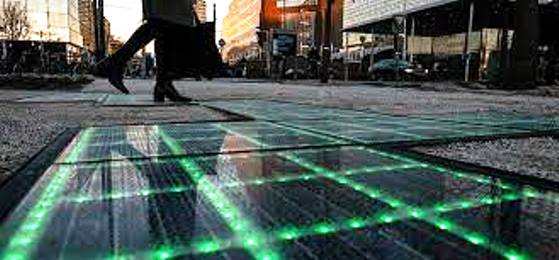As energy costs soar, and global growth rate for 2024 expected to rise to 3.3% Geonode’s team explores a novel solution—energy-generating tiles.
RELATED: The fatal connection between gadgets and thunderstorms
These tiles transform your floor into a power source for your gadgets. This fresh take on curbing energy expenses could pique your readers’ curiosity.
Houses Can Now Produce Free Electricity With Power Tiles
“Is it possible that the very ground beneath our feet might serve as a solution to the energy crisis?” suggested Jensen Finley, a prominent researcher from Geonode. Advances in technology are often unexpected and remarkable. One such development, energy-generating tiles, appears to be an innovative stride poised to help alleviate the current energy crisis.
What are Energy-Generating Tiles?
Before moving further, let’s shed light on what energy-generating tiles are. As the name suggests, these are specially designed tiles capable of converting the kinetic energy of footfalls into electricity. Simply walk over them, and they produce power. “Footfall harvesting,” as Jensen subtly refers to it, taps into the untapped yet abundant source of energy – pedestrian movement.
The mechanics are rather straightforward:
-
Underneath the surface layer of these tiles, there’s what engineers call an ‘energy harvester.’
-
The harvester captures the force exerted by a footfall and transforms it into rotational energy.
-
The rotational energy is then converted into usable electrical power.
The Potential Impact
As cities hustle and bustle with people day and night, the energy-generating tiles could potentially harvest a substantial amount of power. Imagine crowded places such as airports, railway stations, sporting events, or busy sidewalks leveraged for their foot traffic. The potential is enormous, and the implications far-reaching. A single footstep can generate enough electricity to light up a small LED bulb.
“We’re not just talking about a quirky, novelty item”, Finley underscores. “We have an actual, usable, and sustainable power source in energy-generating tiles. They could play a significant role in urban, off-grid architecture in the near future.”
Applications of Energy Generating Tiles
Public Walkways and Squares: High foot traffic areas like city sidewalks, plazas, and transit stations can be fitted with energy-generating tiles to harness power from pedestrian movements.
Street Lighting: The electricity generated from these tiles can be used to power street lights, especially in busy urban areas.
Campus Walkways: In schools and universities, these tiles can be installed in corridors and walkways to generate electricity from the foot traffic, which can then be used for lighting or other electrical needs on campus.
Shopping Malls and Retail Stores: Commercial areas with high foot traffic can benefit from energy-generating tiles by powering interior lighting or electronic displays.
Recreational Areas:
Parks and Playgrounds: Installing energy-generating tiles in parks and playgrounds can help power lighting, water fountains, or even Wi-Fi hotspots.
Transportation Hubs:
Airports and Train Stations: These busy hubs can utilize energy-generating tiles to power signage, information displays, or charging stations.
Event Venues:
Concert Halls and Stadiums: The foot traffic from attendees can be harnessed to power lights, sound systems, or other electrical needs within the venue.
Health and Fitness:
Gyms and Fitness Centers: The movement from individuals working out could be harnessed to generate some power, contributing to the energy needs of the facility.
Disaster Relief and Remote Areas:
Temporary Shelters: In disaster-stricken or remote areas, these tiles can provide a source of power for essential lighting and charging of small devices.
Smart Cities and IoT:
Sensor Networks: The energy generated can power sensors and other small devices forming part of the Internet of Things (IoT) in smart city setups.
Environmental Monitoring:
Remote Sensors: In remote or inaccessible locations, energy-generating tiles could power environmental sensors, reducing the need for battery replacements.
Steps towards Sustainability
In addition to their innovative function, energy-generating tiles promote sustainability in two pivotal ways:
Renewable Energy: The process of converting kinetic energy into electricity is entirely renewable. It doesn’t deplete resources or generate waste products, making it a clean energy source that contributes to a greener future.
Reduced Dependence on Traditional Power: Energy-generating tiles could decrease our dependence on traditional energy sources, reducing greenhouse gas emissions and environmental damage.
As Jensen Finley aptly states, “When you’re dealing with an energy source this promising, the implications go far beyond mere novelty. There’s a genuine potential for change – for advancement towards a sustainable future.”
The Road Ahead
Though energy-generating tiles present a promising solution, one must not forget that every solution comes with a set of challenges. The cost of implementing such technology on a worldwide scale would be astronomical. Also, the question of efficiency is yet to be fully addressed. But scientific advances start small and grow through exploration and innovation.
“It is often said civilization is built on daring ideas; energy-generating tiles could be just the start.” Jensen concludes. “Who knows, in a few decades, we might look down at our pavements not as passive structures but as actively powering our cities and homes.”
Are energy-generating tiles the be-all and end-all solution to the energy crisis? Maybe not. But they are a step – and a bold one at that – in the right direction. And every step, every footfall, can lead us closer to a sustainable, energy-efficient future.





























